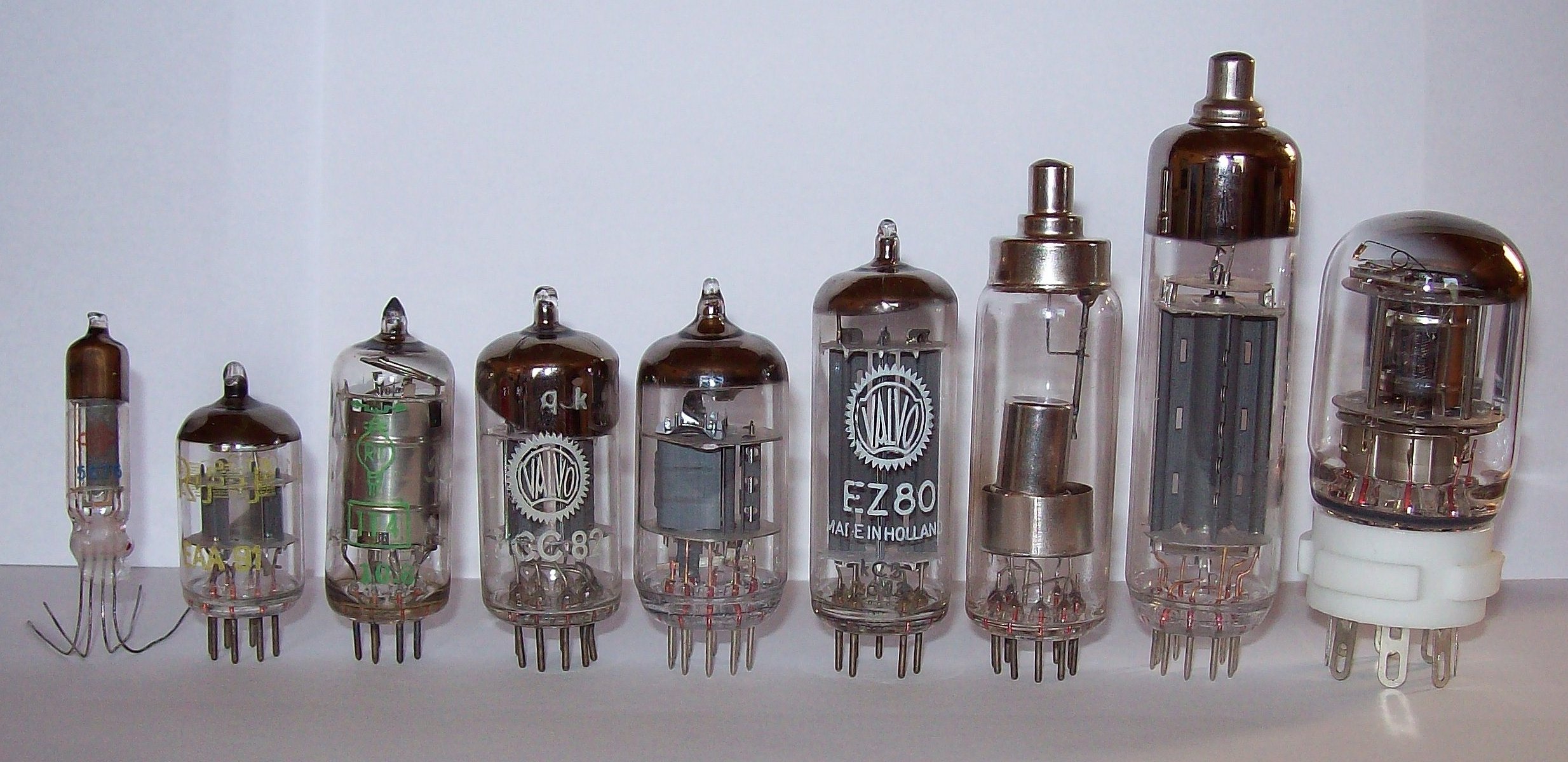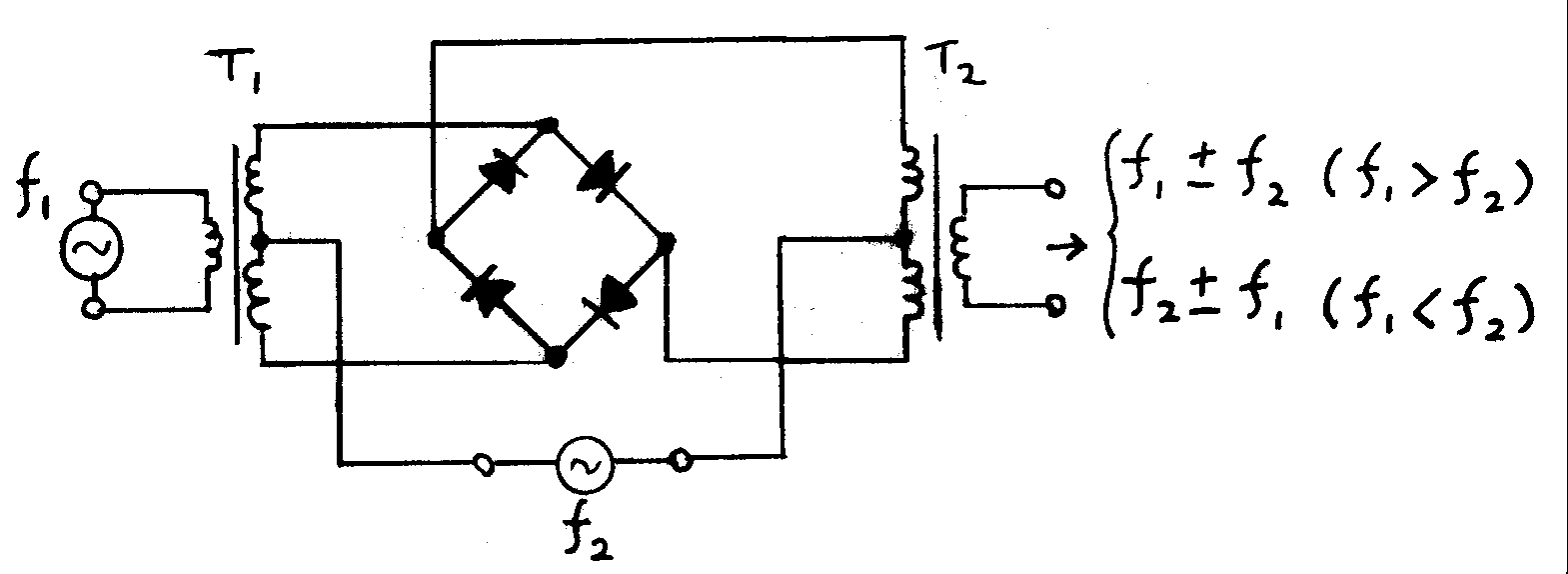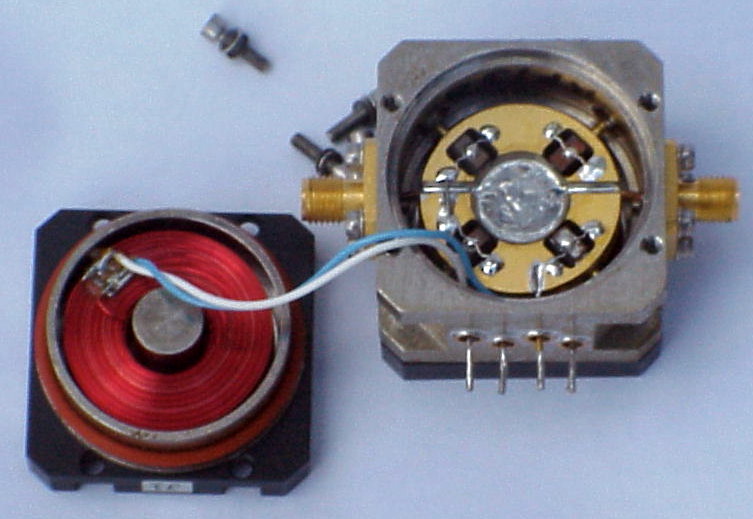|
Frequency Multiplier
In electronics, a frequency multiplier is an electronic circuit that generates an output signal which has a frequency that is a harmonic (multiple) of its input frequency. Frequency multipliers consist of a nonlinear circuit that distorts the input signal and consequently generates harmonics of the input signal. A subsequent bandpass filter selects the desired harmonic frequency and removes the unwanted fundamental and other harmonics from the output. Frequency multipliers are often used in frequency synthesizers and communications circuits. It can be more economical to develop a lower frequency signal with lower power and less expensive devices, and then use a frequency multiplier chain to generate an output frequency in the microwave or millimeter wave range. Some modulation schemes, such as frequency modulation, survive the nonlinear distortion without ill effect (but schemes such as amplitude modulation do not). Frequency multiplication is also used in nonlinear optics. The ... [...More Info...] [...Related Items...] OR: [Wikipedia] [Google] [Baidu] |
Electronics
Electronics is a scientific and engineering discipline that studies and applies the principles of physics to design, create, and operate devices that manipulate electrons and other Electric charge, electrically charged particles. It is a subfield of physics and electrical engineering which uses Passivity (engineering), active devices such as transistors, diodes, and integrated circuits to control and amplify the flow of electric current and to convert it from one form to another, such as from alternating current (AC) to direct current (DC) or from analog signal, analog signals to digital signal, digital signals. Electronic devices have significantly influenced the development of many aspects of modern society, such as telecommunications, entertainment, education, health care, industry, and security. The main driving force behind the advancement of electronics is the semiconductor industry, which continually produces ever-more sophisticated electronic devices and circuits in respo ... [...More Info...] [...Related Items...] OR: [Wikipedia] [Google] [Baidu] |
Nonlinear Circuit
A linear circuit is an electronic circuit which obeys the superposition principle. This means that the output of the circuit ''F(x)'' when a linear combination of signals ''ax1(t) + bx2(t)'' is applied to it is equal to the linear combination of the outputs due to the signals ''x1(t)'' and ''x2(t)'' applied separately: :F(ax_1 + bx_2) = aF(x_1) + bF(x_2)\, It is called a linear circuit because the output voltage and current of such a circuit are linear functions of its input voltage and current. This kind of linearity is not the same as that of straight-line graphs. In the common case of a circuit in which the components' values are constant and don't change with time, an alternate definition of linearity is that when a sinusoidal input voltage or current of frequency ''f'' is applied, any steady-state output of the circuit (the current through any component, or the voltage between any two points) is also sinusoidal with frequency ''f''. A linear circuit with constant comp ... [...More Info...] [...Related Items...] OR: [Wikipedia] [Google] [Baidu] |
Tuned Circuit
An LC circuit, also called a resonant circuit, tank circuit, or tuned circuit, is an electric circuit consisting of an inductor, represented by the letter L, and a capacitor, represented by the letter C, connected together. The circuit can act as an electrical resonator, an electrical analogue of a tuning fork, storing energy oscillating at the circuit's resonant frequency. LC circuits are used either for generating signals at a particular frequency, or picking out a signal at a particular frequency from a more complex signal; this function is called a bandpass filter. They are key components in many electronic devices, particularly radio equipment, used in circuits such as oscillators, filters, tuners and frequency mixers. An LC circuit is an idealized model since it assumes there is no dissipation of energy due to resistance. Any practical implementation of an LC circuit will always include loss resulting from small but non-zero resistance within the components and co ... [...More Info...] [...Related Items...] OR: [Wikipedia] [Google] [Baidu] |
Vacuum Tubes
A vacuum tube, electron tube, thermionic valve (British usage), or tube (North America) is a device that controls electric current flow in a high vacuum between electrodes to which an electric voltage, potential difference has been applied. It takes the form of an evacuated tubular envelope of glass or sometimes metal containing electrodes connected to external connection pins. The type known as a thermionic tube or thermionic valve utilizes thermionic emission of electrons from a hot cathode for fundamental Electronics, electronic functions such as signal amplifier, amplification and current Rectifier, rectification. Non-thermionic types such as vacuum phototubes achieve electron emission through the photoelectric effect, and are used for such purposes as the detection of light and measurement of its intensity. In both types the electrons are accelerated from the cathode to the anode by the electric field in the tube. The first, and simplest, vacuum tube, the diode or Flem ... [...More Info...] [...Related Items...] OR: [Wikipedia] [Google] [Baidu] |
Diode
A diode is a two-Terminal (electronics), terminal electronic component that conducts electric current primarily in One-way traffic, one direction (asymmetric electrical conductance, conductance). It has low (ideally zero) Electrical resistance and conductance, resistance in one direction and high (ideally infinite) resistance in the other. A semiconductor diode, the most commonly used type today, is a Crystallinity, crystalline piece of semiconductor material with a p–n junction connected to two electrical terminals. It has an Exponential function, exponential current–voltage characteristic. Semiconductor diodes were the first Semiconductor device, semiconductor electronic devices. The discovery of asymmetric electrical conduction across the contact between a Crystal, crystalline mineral and a metal was made by German physicist Ferdinand Braun in 1874. Today, most diodes are made of silicon, but other semiconducting materials such as gallium arsenide and germanium are also ... [...More Info...] [...Related Items...] OR: [Wikipedia] [Google] [Baidu] |
Electronic Amplifier
An amplifier, electronic amplifier or (informally) amp is an electronic device that can increase the magnitude of a Signal (information theory), signal (a time-varying voltage or Electric current, current). It is a two-port network, two-port electronic circuit that uses electric power from a power supply to increase the amplitude (magnitude of the voltage or current) of a signal applied to its input terminals, producing a proportionally greater amplitude signal at its output. The amount of amplification provided by an amplifier is measured by its gain (electronics), gain: the ratio of output voltage, current, or power to input. An amplifier is defined as a circuit that has a power gain greater than one. An amplifier can be either a separate piece of equipment or an electrical circuit contained within another device. Amplification is fundamental to modern electronics, and amplifiers are widely used in almost all electronic equipment. Amplifiers can be categorized in different ... [...More Info...] [...Related Items...] OR: [Wikipedia] [Google] [Baidu] |
Transistor
A transistor is a semiconductor device used to Electronic amplifier, amplify or electronic switch, switch electrical signals and electric power, power. It is one of the basic building blocks of modern electronics. It is composed of semiconductor material, usually with at least three terminal (electronics), terminals for connection to an electronic circuit. A voltage or Electric current, current applied to one pair of the transistor's terminals controls the current through another pair of terminals. Because the controlled (output) power can be higher than the controlling (input) power, a transistor can amplify a signal. Some transistors are packaged individually, but many more in miniature form are found embedded in integrated circuits. Because transistors are the key active components in practically all modern electronics, many people consider them one of the 20th century's greatest inventions. Physicist Julius Edgar Lilienfeld proposed the concept of a field-effect transisto ... [...More Info...] [...Related Items...] OR: [Wikipedia] [Google] [Baidu] |
Frequency Mixer
In electronics, a mixer, or frequency mixer, is an electrical circuit that creates new frequencies from two signals applied to it. In its most common application, two signals are applied to a mixer, and it produces new signals at the sum and difference of the original frequencies. Other frequency components may also be produced in a practical frequency mixer. Mixers are widely used to shift signals from one frequency range to another, a process known as heterodyning, for convenience in transmission or further signal processing. For example, a key component of a superheterodyne receiver is a mixer used to move received signals to a common intermediate frequency. Frequency mixers are also used to modulation, modulate a carrier signal in Transmitter, radio transmitters. Types The essential characteristic of a mixer is that it produces a component in its output which is the product of the two input signals. Both active and passive circuits can realize mixers. Passive mixers use ... [...More Info...] [...Related Items...] OR: [Wikipedia] [Google] [Baidu] |
Varicap
A varicap diode, varactor diode, variable capacitance diode, variable reactance diode or tuning diode is a type of diode designed to exploit the voltage-dependent capacitance of a reverse-biased p–n junction. Applications Varactors are used as voltage-controlled capacitors. They are commonly used in voltage-controlled oscillators, parametric amplifiers, and frequency multipliers. Voltage-controlled oscillators have many applications such as frequency modulation for FM transmitters and phase-locked loops. Phase-locked loops are used for the frequency synthesizers that tune many radios, television sets, and cellular telephones. The varicap was developed by the Pacific Semiconductor subsidiary of the Ramo Wooldridge Corporation who received a patent for the device in June 1961. The device name was also trademarked as the "Varicap" by TRW Semiconductors, the successor to Pacific Semiconductors, in October 1967. This helps explain the different names for the device as it ... [...More Info...] [...Related Items...] OR: [Wikipedia] [Google] [Baidu] |
YIG Sphere
Yttrium iron garnet spheres (YIG spheres) serve as magnetically tunable filters and resonators for microwave frequencies. YIG filters are used for their high Q factors, typically between 100 and 200. A sphere made from a single crystal of synthetic yttrium iron garnet acts as a resonator. The field from an electromagnet changes the resonance frequency of the sphere and hence the frequency it will allow to pass. The advantage of this type of filter is that the garnet can be tuned over a very wide frequency range by varying the strength of the magnetic field. Some filters can be tuned from 3 GHz up to 50 GHz. Construction The YIG spheres themselves are on the order of 0.5 mm in diameter and are manufactured from slightly larger cubes of diced material by tumbling, as is done in the manufacture of jewelry. The garnet is mounted on a ceramic rod, and a pair of small loops around the sphere couple fields into and out of the sphere; the loops are half-turns ... [...More Info...] [...Related Items...] OR: [Wikipedia] [Google] [Baidu] |
YIG Filter
Yttrium iron garnet spheres (YIG spheres) serve as magnetically tunable signal processing, filters and resonators for microwave frequencies. YIG filters are used for their high Q factors, typically between 100 and 200. A sphere made from a single crystal of synthetic yttrium iron garnet acts as a resonator. The field from an electromagnet changes the resonance frequency of the sphere and hence the frequency it will allow to pass. The advantage of this type of filter is that the garnet can be tuned over a very wide frequency range by varying the strength of the magnetic field. Some filters can be tuned from 3 GHz up to 50 GHz. Construction The YIG spheres themselves are on the order of 0.5 mm in diameter and are manufactured from slightly larger cubes of diced material by tumble finishing, tumbling, as is done in the manufacture of jewelry. The garnet is mounted on a ceramic rod, and a pair of small Loop_antenna, loops around the sphere couple fields into and ... [...More Info...] [...Related Items...] OR: [Wikipedia] [Google] [Baidu] |
Step Recovery Diode
In electronics, a step recovery diode (SRD, snap-off diode or charge-storage diode or memory varactor) is a Diode#Semiconductor diodes, semiconductor junction diode with the ability to generate extremely short pulses. It has a variety of uses in microwave (MHz to GHz range) electronics as pulse generator or parametric amplifier. When diodes switch from forward conduction to reverse cut-off, a reverse current flows briefly as stored charge is removed. It is the abruptness with which this reverse current ceases which characterises the step recovery diode. Historical note The first published paper on the SRD is : the authors start the brief survey stating that "the recovery characteristics of certain types of Diode#p–n junction diode, pn-junction diodes exhibit a discontinuity which may be used to advantage for the generation of harmonics or for the production of nanosecond, millimicrosecond pulses". They also refer that they first observed this phenomenon in February, 1959 O ... [...More Info...] [...Related Items...] OR: [Wikipedia] [Google] [Baidu] |





